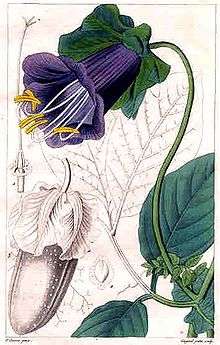Cobaea scandens
| Cobaea scandens | |
|---|---|
 | |
| Scientific classification | |
| Kingdom: | Plantae |
| Clade: | Angiosperms |
| Clade: | Eudicots |
| Clade: | Asterids |
| Order: | Ericales |
| Family: | Polemoniaceae |
| Genus: | Cobaea |
| Species: | C. scandens |
| Binomial name | |
| Cobaea scandens | |

by Pancrace Bessa
Cobaea scandens, the cup-and-saucer vine, cathedral bells, Mexican ivy, or monastery bells, is a species of flowering perennial plant of the Polemoniaceae family, native to the tropical Americas.
It is widely cultivated for its twining habit and its highly ornamental, bell-shaped flowers, 5 cm (2 in) long, which change from white to purple. It is not hardy, and requires protection from winter frost and winds.[1] It has gained the Royal Horticultural Society's Award of Garden Merit[2] (confirmed 2017).[3] A white form exists, C. scandens f. alba.[4]
This plant has become a common weed in New Zealand, probably as a garden escape.
References
- ↑ Brickell, Christopher (2008). RHS A-Z Encyclopedia of Garden Plants. United Kingdom: Dorling Kindersley Publishers Ltd. p. 1136. ISBN 1405332964.
- ↑ "RHS Plant Selector - Cobaea scandens". Retrieved 17 June 2013.
- ↑ "AGM Plants - Ornamental" (PDF). Royal Horticultural Society. July 2017. p. 22. Retrieved 24 January 2018.
- ↑ "RHS Plant Selector - Cobaea scandens f. alba". Retrieved 16 June 2013.
- Pink, A. (2004). Gardening for the Million. Project Gutenberg Literary Archive Foundation.
External links
- Cobaea scandens
- Cobaea scandens
- (in Spanish) Cobaea scandens
This article is issued from
Wikipedia.
The text is licensed under Creative Commons - Attribution - Sharealike.
Additional terms may apply for the media files.